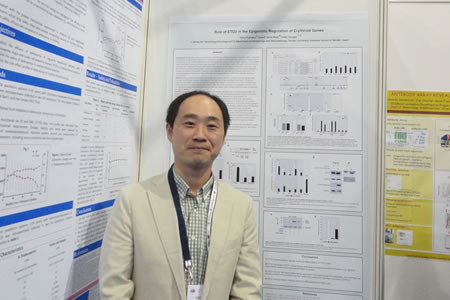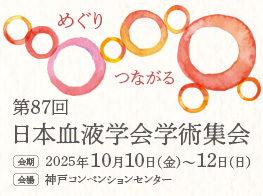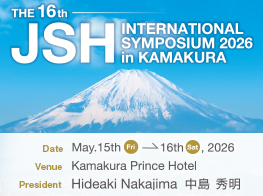名前:藤原 亨【東北大学大学院医学系研究科 血液分子治療学寄附講座】
発表日時:2011年6月11日 17:30 -18:45
発表形式:Poster
Title:
Role of ETO2 in the epigenetic regulation of erythroid genes
Abstract:
Background
Developmental control mechanisms often utilize multimeric complexes containing transcription factors, coregulators, and additional non-DNA binding components. It is challenging to ascertain how such components contribute to complex function at endogenous loci. We recently analyzed the function of components of a complex containing master regulators of hematopoiesis (GATA-1 and Scl/TAL1) and the non-DNA binding components ETO2, the LIM domain protein LMO2, and the chromatin looping factor LDB1. We revealed that ETO2 and LMO2 regulate distinct target gene ensembles in erythroid cells. Furthermore, it was found that ETO2 commonly represses GATA-1 function via suppressing histone H3 acetylation, and also regulates methylation of histone H3 at lysine 27 (H3-trimeK27) at select loci, which suggested that ETO2 might be an important determinant of the erythroblast epigenome (Fujiwara et al. PNAS. 2010). Here, we investigated the role of ETO2 in the epigenetic regulation of erythroid genes.
Methods
CBFA2T3 mRNA (which encodes ETO2 protein) was cloned into pcDNA3.1 (Clontech) and Flexi HaloTag vector (Promega), and ETO2 was transiently overexpressed in K562 cells using Amaxa nucleofection technology™ (Amaxa Inc.). Quantitative ChIP analysis was performed using anti-acetylated H3K9 (abcam), anti-trimethyl H3 (Lys 9 and 27) (Millipore) and anti-Myc (Santa Cruz). To induce erythroid differentiation of K562 cells, hemin was treated at a concentration of 30 uM for 24h. For transcription profiling, human whole expression array was used (Agilent). Gene Ontology analysis was based on DAVID software (http://david.abcc.ncifcrf.gov/home.jsp).
Results
Overexpression of ETO2 in hemin-treated K562 cells resulted in decreased ratio of benzidine-staining positive cells, suggesting that ETO2 retards the erythroid differentiation of K562 cells. Next, we conducted microarray analysis to characterize ETO2 target gene ensemble in K562 cells. The analysis demonstrated that 598 genes were downregulated in the ETO2-overexpressed cells (> 2 fold). To test what percentages of ETO2-repressed genes could be direct target genes of GATA-1 or GATA-2 in K562 cells, we merged the microarray results with ChIP-seq profile (n= 5,749 and n=21,167 for GATA-1 and GATA-2 ChIP-seq, respectively) (Fujiwara et al. Mol Cell. 2009), and demonstrated that 23.1% and 40.5% of ETO2-repressed genes contained significant GATA-1 and GATA-2 peaks in their loci, respectively. Gene Ontology analysis among ETO2-repressed genes revealed significant enrichment of genes related to “oxygen transporter” and “hemoglobin complex” (p=0.00128). Overexpression of ETO2 in K562 cells resulted in the significant decrease in the expression of globin genes such as HBG, HBB, HBE1, HBA, HBM and HBZ by quantitative RT-PCR. Quantitative ChIP analysis revealed ETO2 occupancy at globin HS2. Furthermore, the overexpression significantly increased H3-trimeK27 and reduced acetylated H3K9 at ・-globin promoter. Co-immunoprecipitation analysis revealed the interaction between ETO2 and EZH2, a member of polycomb repressor complex. We are currently analyzing the mechanism of ETO2-dependent transcriptional repression and how ETO2-dependent histone marks are established in erythroid cells.
Conclusion
In conjunction with the evidence that ETO2 binds histone deacetylases and associates with GATA-Scl/TAL1 complex that binds epigenetic modifiers, ETO2 appears to have important roles in establishing the erythroblast epigenome. We consider this is important from the perspective of elucidating mechanisms of hematopoiesis and leukemogenesis.
EHA congress 印象記:
この度、2011年6月9日から12日にかけてロンドンで開催された16th EHA congressに参加させて頂きました。ロンドンへは成田空港からの直行便があるため乗り継ぎの心配はなかったのですが、ロンドン到着後、入国審査を待つ長蛇の列に驚かされました。
学会は市街中心部からやや西よりに位置するExCel Londonで開催されました。EHA参加は今回が初めてでしたが、米国血液学会(ASH)と比較して全体がコンパクトで、会場内での移動が容易であったのが印象的でした。また電車の駅と会場も直結していたため、ホテルからの往復も比較的楽でした。
学会全体を通じて、臨床の演題発表が比較的多い印象でした。私が特に興味深いと感じたのは、Molecular Hematology Workshopというセッションでした。本セッションでは、有名な研究者が短い時間の中で最新の結果を発表するというものでした。約3時間超にわたるセッションの中で多くの興味深い発表を聞くことが出来、充実した時間となりました。また、ポスターセッションでは通常の自由な質疑応答の他に、テーマごとに担当者がおり1つ1つのポスターについてDiscussionを行うという形式でした。この発表を通じて、自分の実験で足りない部分や大まかな方向性について確認できる良い機会であったと思います。
今回、日本血液学会のTravel Award募集が本会参加へのきっかけとなりましたが、実際に参加してみたところ非常に良い学会であったと思いました。国際学会の経験が多くない若手研究者にとって、よい発表の場になりうるのではないかと感じました。
この度、Travel Awardを頂くことが出来、大変光栄に思います。他の採択者やEHAに参加された日本血液学会の会員の方々と交流する機会も得ることができ、貴重な財産となりました。このような機会を与えて頂きました、日本血液学会・国際委員会及び事務局の方々に、厚くお礼申し上げます。




